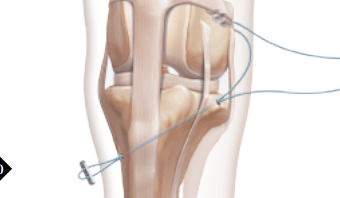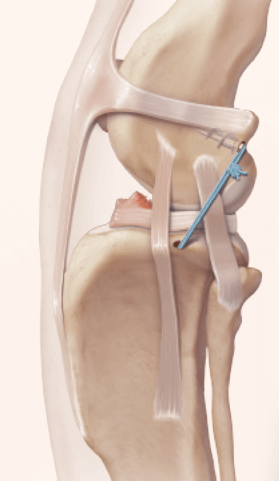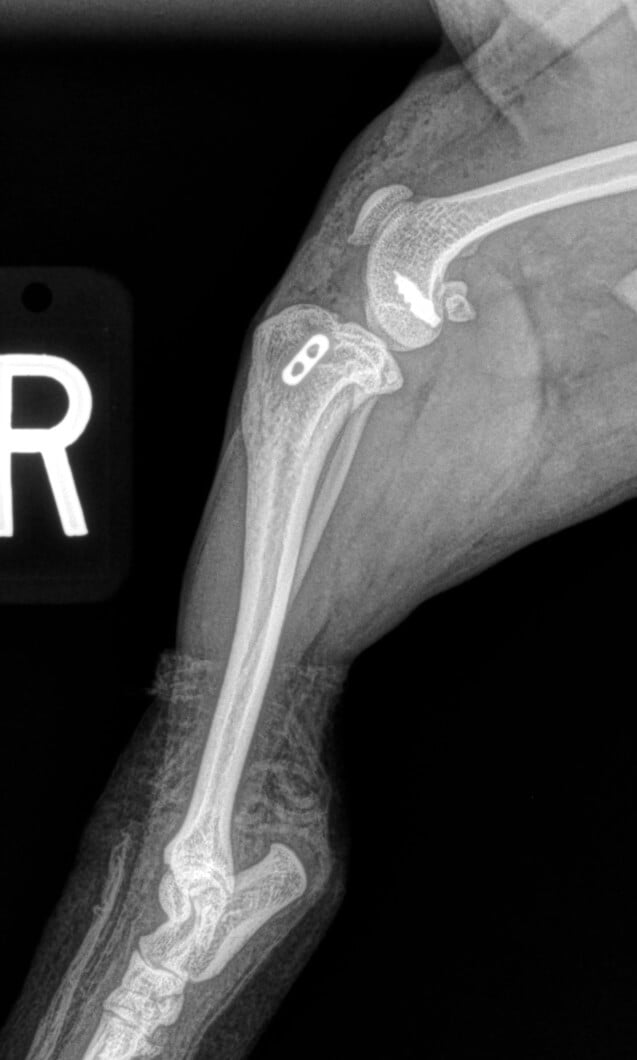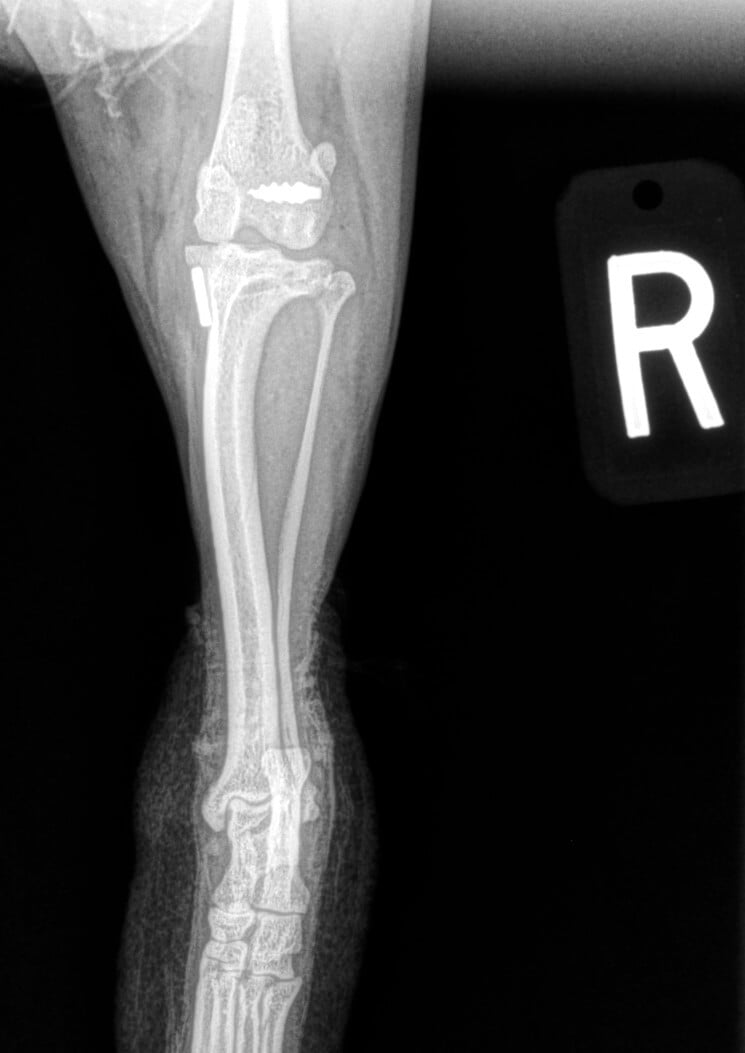Extra-capsular Stabilization Physical Exam
The exam starts by observing the dog walking to confirm which limb they are lame on. All limbs will then be examined to check for any loss of range of motion, crepitus (grating within the joint), or effusions (swellings) within the joints. The stability of both stifles is assessed by checking for tibial thrust and cranial drawer. If instability can not be demonstrated with the patient conscious, the tests may be repeated with the patient sedated. Other body systems are assessed to ensure that there are no other health issues that may prevent surgery or must be assessed before surgery can be scheduled. Any dental disease should be corrected prior to surgery being scheduled.
Extra-capsular Stabilization Pre-Surgical Bloodwork and ECG
Blood is collected to check for any underlying health issues that may indicate the patient is not a good candidate for surgery. This includes CBC, chemistry, PT, and PTT (Antech WSA050). An ECG is also submitted using telemedicine to check for abnormalities.
Extra-capsular Stabilization Pre-Surgical Radiographs.
Orthogonal radiographs of both stifles are obtained and assessed. In the majority of cases, an effusion is visible within the stifle that demonstrates inflammation and pathology of the joint. The joint is assessed for other diseases such as osteochondritis dissecans (OCD), or neoplasia (cancer). Chronic cruciate injuries or those with concurrent meniscal damage tend to have an increased amount of degenerate changes visible on the radiographs.
The Day Of Extra-capsular Stabilization Surgery
The patient will be fasted overnight to ensure that they do not regurgitate food and then inhale it into their lungs the following day whilst under anesthesia, this is called inhalation pneumonia. The patient will be pre-medicated with a combination of an opioid and a sedative. Once the dog is pre-medicated, radiographs will be obtained if not recently obtained by our hospital. The patient's affected leg will be shaved from the middle of the body all the way down to the hock.
Extra-capsular Stabilization Anesthesia
An intravenous (IV) catheter is placed into one of the cephalic veins. The patient will receive IV Fluids whilst their injured leg is being shaved. The IV fluids increase the circulating volume of blood which helps maintain a normal blood pressure whilst the patient is anesthetized. Anesthesia is induced with an injection of a drug called propofol. Once the patient has fallen asleep an endotracheal tube is inserted into their trachea through their mouth to facilitate the administration of oxygen and a gaseous anesthetic called isoflurane. Sensors are hooked up to the patient to allow measurement of the pet's heart rate, ECG trace, blood pressure, end-tidal carbon dioxide levels,
An epidural injection of preservative-free morphine and bupivacaine is administered to the patient. The epidural provides around 6 hours of desensitization of the pelvic limbs.
Intravenous antibiotics are started to build up the concentration of antibiotics in the patient's bloodstream.
Extra-capsular Stabilization Surgical Scrub And Limb Draping
The patient is positioned on their back. A cover is placed over the unclipped hair of the paw and the leg, while the affected leg is suspended and aseptically prepared using a 4% chlorhexidine solution.
The patient is transferred into the operating room where the patient is positioned for surgery and reconnected to anesthetic monitors. The ground plate for the electrocautery machine is applied to a shaved spot on the patient's thigh. Whilst the injured limb is still suspended the limb is isolated with sterile drapes. An iodine impregnated wrap (Ioban) is applied to the limb. This aids in maintaining sterility of the operating site by preventing contact between the surgeon and the skin of the patient. Whilst the skin has been cleaned and the amount of bacteria now present on the skin has been significantly reduced there are still some bacteria present.
Extra-capsular Stabilization Incision
An incision is made on the outer side of the stifle (knee)
Extra-capsular Stabilization Joint Explore
An incision is made into the joint capsule, this procedure is called an arthrotomy. The joint is lavaged and the internal structures are examined. Remnants of the damaged cranial cruciate ligament are removed as it serves no purpose after the joint has been stabilized and the remnants could create a future source of pain. The medial and lateral menisci are cartilage pads that help to transfer weight from the femur to the tibia. These cartilages are examined. If damaged, then the damaged portion is removed (partial meniscectomy) or the entire meniscus may be removed (complete meniscectomy). The joint is lavaged and the joint capsule is sutured closed with a dissolvable suture.
Extra-capsular Stabilization
 |
 |
Extra-capsular Stabilization Post Surgical Radiographs
 |
 |
Whilst the patient is still anesthetized the patient is taken into radiology for post-surgery radiographs (X-rays). The radiographs are assessed to ensure the apparatus FasTak screw and toggle are appropriately positioned.
Extra-capsular Stabilization Recovery From Anesthesia
After the post-surgical radiographs have been reviewed by the surgeon, the patient is moved through to recovery. The patient's leg is cleaned and a light padded bandage is applied to the limb to help prevent post-surgical swelling.
The patient is extubated and moved through to a recovery kennel. The epidural (bupivacaine and morphine) provides 6-hours of post-surgical relief for the patient. This equates to 3-4 hours of pain relief after the patient has woken up from anesthesia. After the epidural has worn off the patient will be able to walk out to the bathroom and already be able to place weight on their operate limb. Most patients will feel good enough to enjoy a nice dinner after surgery.
Extra-capsular Stabilization Post Surgical Care
For routine procedures, the usual hospital stay is 2-3 days. We often board patients for a longer duration after surgery when their owners feel they are unable to provide the necessary care required during the recovery period. A light padded bandage is applied to the operated limb to help reduce post-surgical bruising and swelling.
Typical rechecks are at 2, 6, and 12 weeks.
How Much Does Extra-capsular Stabilization Surgery Cost?
$3,950
This includes, an orthopedic exam, pre-operative blood work, pre, and post-surgical radiographs, anesthesia, surgical time, hospitalization, game-ready cold compression therapy, and post-operative pain relief and recheck examinations.
Reviews from Extra-capsular Stabilization Surgery
"Dr Trathan performed surgery on my dog Milo. I was refered by my normal vet to a specialty hospital in Dublin. I didn't like the vet there and decided to look online for other options. Dr Trathan kept coming up in the search results so we decided to take a drive to Oakdale. We are so glad we made the drive. Dr Trathan Milo feel comfortable straight away. Dr Trathan kept us updated after surgery and even gave us his cellphone to call him incase we needed after we took Milo home. Milo is now back to his crazy self and you would never know he hurt his leg."
- Marvin and Milo Lindley" 06.25.2019
